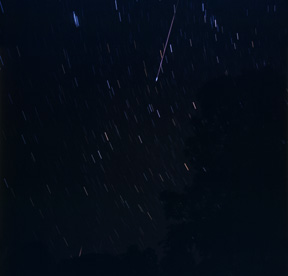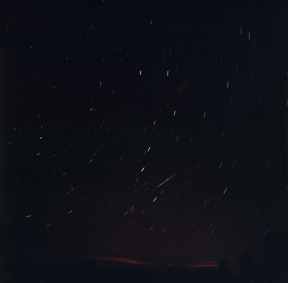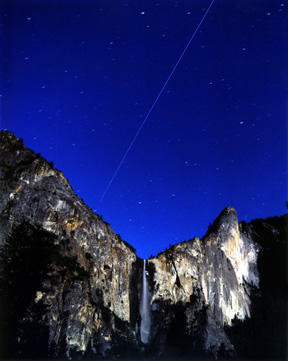Golden Gate Photo - Leonid Meteor Storm
Fine Art Photography of the November Leonid Meteor Storms of 2001 and 2002.
The Leonid meteor shower is an annual occurrance in mid-November as the Earth passes through a zone of debris left by the parent comet 55P/Tempel-Tuttle. It gets its name from the portion of the sky from where the meteors appear to radiate, in this case, the constellation Leo. Every 33.2 years the parent comet orbits around the sun and leaves a new stream of debris particles behind in its orbit. Each orbit results in a slightly offset trail of debris. When the Earth passes through this area of debris trails, there is the potential for a meteor "storm" depending on which trails are crossed and where it passes through them. In normal years, an observer may see an average of 10 to 15 meteors per hour during the peak of the shower. But when the Earth passes through a relatively dense debris trail, the rate may climb into the thousands per hour or more. Those storm peak times tend to be very short (no more than a few hours) and may only be visible across a small portion of the Earth (weather permitting). In this gallery, there are images from the meteor storm in the early morning of November 18, 2001, and November 19, 2002. In order to effectively capture meteors on film, a light-sensitive film, tripod, and long exposure time are a must. In all of these images, I used Fuji NPH 400 ASA film, 50mm lens (wide-angle) and an F-stop of 4.0 (except the last image, which was F-5.6). The Leonid meteors hit the atmosphere at a rate of over 140,000 miles per hour (70 Km per second), making all but the brightest ones challenging to capture on film. The exposure times are noted below. Note that in these long time-exposures, the stars move across the sky and their paths form a slight arc concentrically around the North Star (out of view). The meteors are distinguished by (typically) straight paths at an angle to the trend of the stars. Also, the meteors often burn in the atmosphere at an uneven rate, which can be seen in the images as an apparent swelling of the streak (where it was brighter). This is particularly true for the larger Leonid meteors (or fireballs), which often produce a vivid flash near the end of their path. Detailed information on the Leonid meteor shower can be found in the American Meteor Society-sponsored website.
|

|
Leonid Fireball
This image is from the November 18, 2001 meteor storm, taken from Mustang Ridge in San Benito County, California. This was taken at 2:42 AM and has an exposure time of 8 minutes. Among the many star trails is a bright Leonid fireball. In this image (and in the close-up), the wider portion of the trail represents the vivid flash near the end of streak across the sky. Also note that the hue changes as well.
Print No. A01-55-8
|
|

|
Leonid Meteor Smoke Trail
This image is also from the November 18, 2001 meteor storm and from the same place as above. This was taken at 2:50 AM and has an exposure time of 6 minutes. After some particularly bright meteors vaporize in the atmosphere, they leave a smokey trail which sometimes can be seen for many minutes after the meteor has extinguished. These trails of hot ionized gas slowly migrate and become deformed by high-altitude winds. If you look closely at the brighter stars, you will recognize the Big Dipper. The smoke trail is located just to the right of the 'cup' of the Big Dipper, but is best seen in this close-up.
Print No. A01-55-9
|
|

|
Leonid Meteor over Yosemite
This image is from the November 19, 2002 storm looking east from the Wawona Tunnel overlook in Yosemite National Park, California. This was taken at 3:23 AM and has an exposure time of 7 minutes. There was a near-full moon in the western sky at the time, which made it impossible to see many of the meteors, but allowed the landscape to be illuminated in this time-exposure. One bright meteor is visible just above El Capitan on the left side of the image. The other streaks are star tracks.
Print No. A02-45-2
More images of Yosemite National Park, California
|
|

|
International Space Station over Moonlit Bridalveil Fall
This image is also from the night of the November 19, 2002 meteor storm in Yosemite National Park. This was taken at 5:16 AM and has an exposure time of 2 minutes. Unlike the above images, there are no visible meteors here. However, the International Space Station (or ISS) was making a fly-over from the western to the southeastern portion of the sky later in the evening. The ISS orbits between 235 and 250 miles (380-400 Km) above Earth. In this view, looking south across the Merced River at a moon-illuminated Bridalveil Fall, the path of the ISS is traced by sunlight reflecting from the spacecraft as it heads toward the southeast at a speed of over 17,000 miles per hour (28,000 Km/hour)!
Print No. A02-45-11
|
BACK TO EARTH AND SKY GALLERY BACK TO MAIN GALLERY
For all photograph orders, please record the Print Number and Title and refer to the Order Form.
Have comments or suggestions for this website? Send Me an E-Mail
Website design and all images in this site by Cleet Carlton ©1999 to the present. All photographs are copyright protected.




